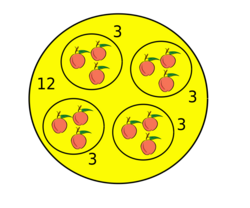Quotient
 From HandWiki - Reading time: 4 min
From HandWiki - Reading time: 4 min
| Arithmetic operations | ||||||||||||||||||||||||||||||||||||||||||
|
||||||||||||||||||||||||||||||||||||||||||
In arithmetic, a quotient (from Latin: quotiens 'how many times', pronounced /ˈkwoʊʃənt/) is a quantity produced by the division of two numbers.[1] The quotient has widespread use throughout mathematics, and is commonly referred to as the integer part of a division (in the case of Euclidean division),[2] or as a fraction or a ratio (in the case of proper division). For example, when dividing 20 (the dividend) by 3 (the divisor), the quotient is "6 with a remainder of 2" in the Euclidean division sense, and [math]\displaystyle{ 6\tfrac{2}{3} }[/math] in the proper division sense. In the second sense, a quotient is simply the ratio of a dividend to its divisor.
Notation
The quotient is most frequently encountered as two numbers, or two variables, divided by a horizontal line. The words "dividend" and "divisor" refer to each individual part, while the word "quotient" refers to the whole.
[math]\displaystyle{ \dfrac{1}{2} \quad \begin{align} & \leftarrow \text{dividend or numerator} \\ & \leftarrow \text{divisor or denominator} \end{align} \Biggr \} \leftarrow \text{quotient} }[/math]
Integer part definition
The quotient is also less commonly defined as the greatest whole number of times a divisor may be subtracted from a dividend—before making the remainder negative. For example, the divisor 3 may be subtracted up to 6 times from the dividend 20, before the remainder becomes negative:
- 20 − 3 − 3 − 3 − 3 − 3 − 3 ≥ 0,
while
- 20 − 3 − 3 − 3 − 3 − 3 − 3 − 3 < 0.
In this sense, a quotient is the integer part of the ratio of two numbers.[3]
Quotient of two integers
A rational number can be defined as the quotient of two integers (as long as the denominator is non-zero).
A more detailed definition goes as follows:[4]
- A real number r is rational, if and only if it can be expressed as a quotient of two integers with a nonzero denominator. A real number that is not rational is irrational.
Or more formally:
- Given a real number r, r is rational if and only if there exists integers a and b such that [math]\displaystyle{ r = \tfrac a b }[/math] and [math]\displaystyle{ b \neq 0 }[/math].
The existence of irrational numbers—numbers that are not a quotient of two integers—was first discovered in geometry, in such things as the ratio of the diagonal to the side in a square.[5]
More general quotients
Outside of arithmetic, many branches of mathematics have borrowed the word "quotient" to describe structures built by breaking larger structures into pieces. Given a set with an equivalence relation defined on it, a "quotient set" may be created which contains those equivalence classes as elements. A quotient group may be formed by breaking a group into a number of similar cosets, while a quotient space may be formed in a similar process by breaking a vector space into a number of similar linear subspaces.
See also
- Product (mathematics)
- Quotient category
- Quotient graph
- Integer division
- Quotient module
- Quotient object
- Quotient of a formal language, also left and right quotient
- Quotient ring
- Quotient set
- Quotient space (topology)
- Quotient type
- Quotition and partition
References
- ↑ "Quotient". http://dictionary.reference.com/browse/quotient.
- ↑ Weisstein, Eric W.. "Integer Division" (in en). https://mathworld.wolfram.com/IntegerDivision.html#:~:text=Integer%20division%20is%20division%20in,and%20is%20the%20floor%20function..
- ↑ Weisstein, Eric W.. "Quotient". http://mathworld.wolfram.com/Quotient.html.
- ↑ Epp, Susanna S. (2011-01-01). Discrete mathematics with applications. Brooks/Cole. pp. 163. ISBN 9780495391326. OCLC 970542319.
- ↑ "Irrationality of the square root of 2.". https://www.math.utah.edu/~pa/math/q1.html.
 KSF
KSF
